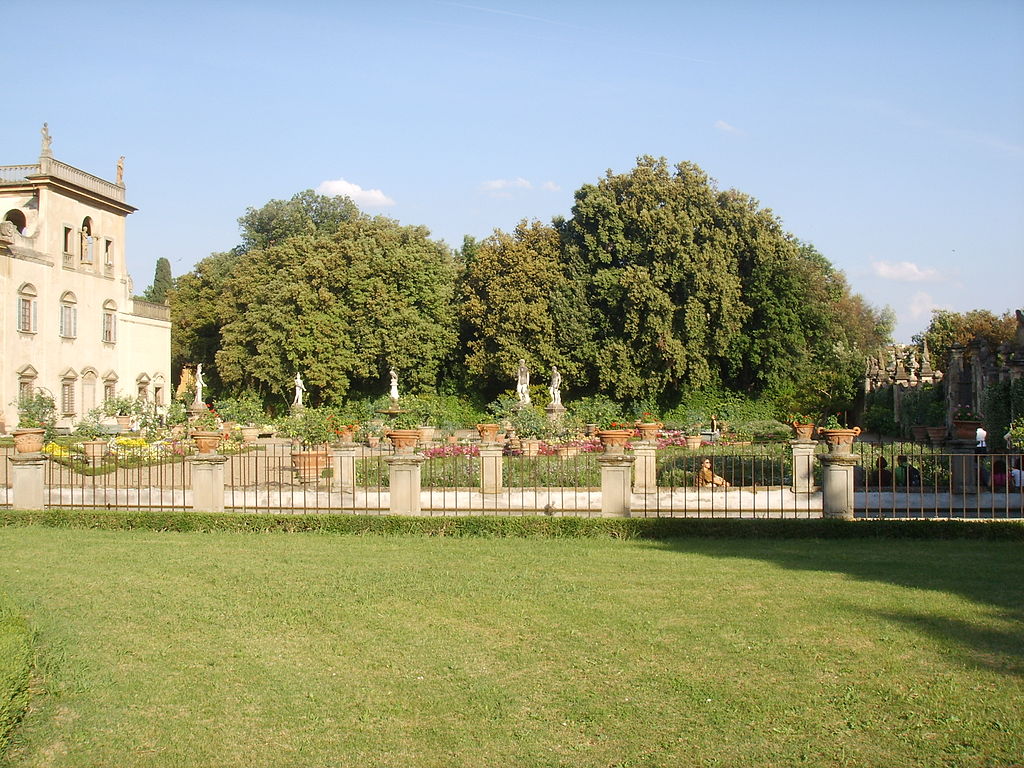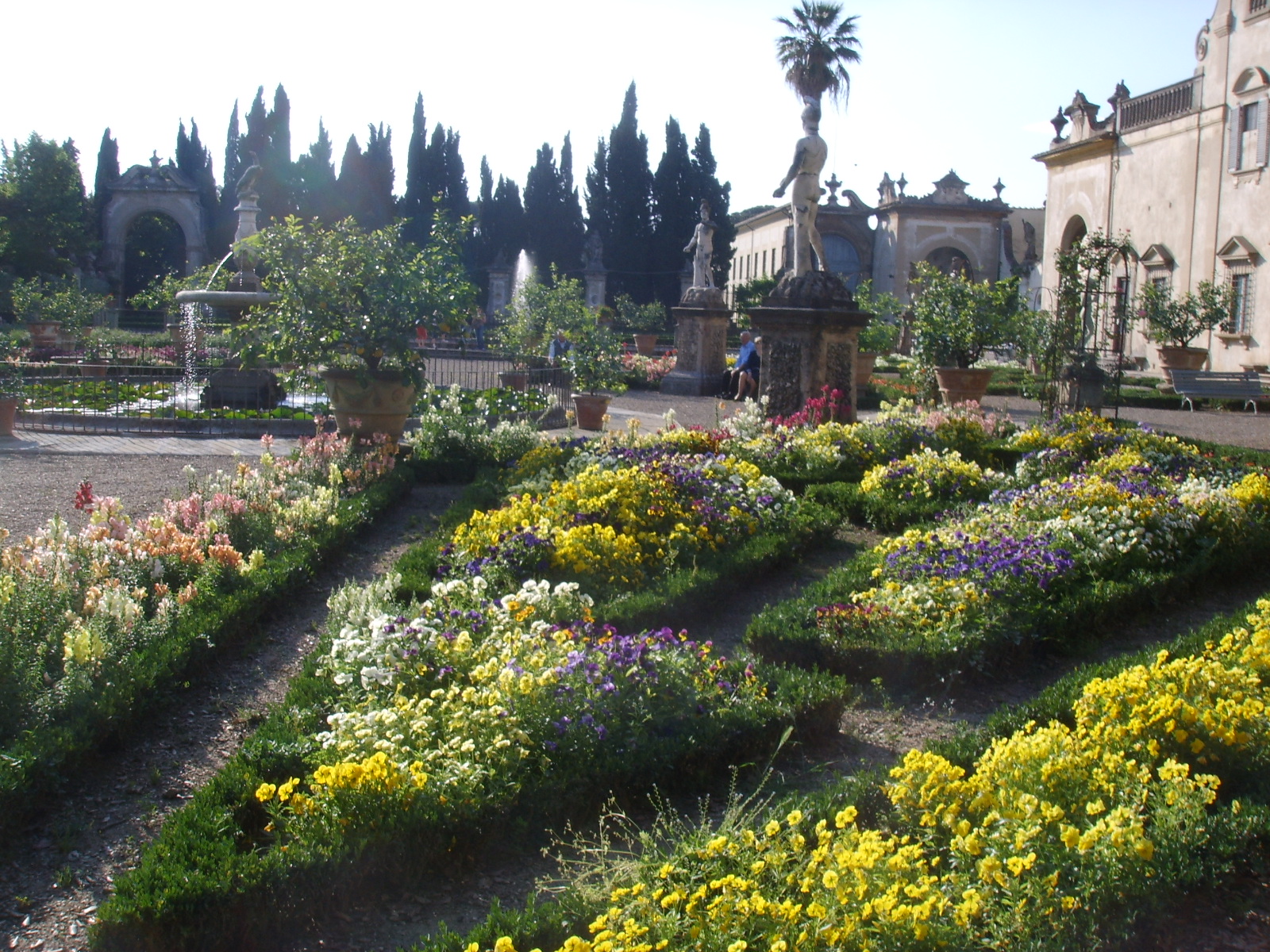
Villa Guicciardini Corsi Salviati
This post is also available in:
 Italiano (Italian)
Italiano (Italian)
Villa Giucciardini Corsi Salviati is in Sesto Fiorentino (FI).
The first information about the main building and the garden date back to the beginning of 1502: Simone di Jacopo Corsi bought what was recorded as “a farm located in San Martino in Sesto, with a house for a lord and a worker with a walled garden”, from Luca di Andrea Carnecchi.
The first transformations took place around the middle of the XVII century. The villa was enlarged and its appearance modified; everything was renovated again in the following century.
The garden was painstakingly enlarged and restructured. In the XVII century, two elliptical basins (still visible today) were placed at the entrance; then, the Italian garden was built with rectangular flower beds bordered by boxwood, along with a fish pond, a vegetable garden, a “selvatico” (a grove of evergreen trees), and a lemon grove.
Between 1708 and 1750 many further embellishments were added: decorations and stuccoes, four terraced towers with loggias, balustrades, statues, pinnacles and urns. Furthermore, a large geometric parterre was built in front to the building, and the layout of the Italian garden was transformed with a series of triangular and trapezoidal flower beds; the oval basins were also surrounded by concentric flower beds. The fishpond was modified with a rectangular shape and fitted with a wrought iron railing marked by stone parallelepipeds holding flower vases; at the corners, four statues of the Seasons were neatly arranged. A large circular pool with many jets of water was built as well inside a lawn bordered by box hedges; the new lemon grove was added (it is now home to an acting school). The south wall was enriched with wrought iron gates, and a ragnaia (a wood fitted with nests for catching birds) of holm oaks was built: it was more than 984-ft long and crisscrossed by several paths. In 1750, thanks to the great supply of water obtained by Marquis Antonio, the latter facility was equipped with a masonry canal with thirteen small waterfalls and, at its ends, a hemicycle basin with two stone dolphins. A small basin with two niches and mosaic decorations was added as well.
A labyrinth was built in the XVII century grove, soon replaced by a pomerium, while a bunch of holm oaks was planted in the vegetable garden. In the XIX century, the latter was transformed according to the popular English landscape style: the holm oak forest was replaced by an artificial lake featuring an islet with a rustic hut and a stone bridge. Two small hills were created and several tall trees including Lebanon cedars (Cedrus Libani) replaced the lemon specimens in the meadows.
The XVIII century flower beds in the parterre were destroyed to make way for many palm trees. Two powerful greenhouses, heated by steam stoves, were built to house exotic plants, including palm trees and orchids. In the woods, several winding paths and wide open clearings were created as well.
In 1907, the villa and the garden were inherited by Count Giulio Guicciardini Corsi Salviati (1887-1958), who abandoned the cultivation of exotic species and restored, the garden to its XVIII century look – without, nonetheless, completely destroying several elements inserted over time by his predecessors. The parterre was rebuilt according to the Baroque style of the second half of the XVIII century, with several seasonal blooms. The trees were thinned and only a few palm trees remained. The two greenhouses were eventually demolished.
After the First World War, the English wood was redesigned with a regular layout, perspective axes and optical illusions devised to ideally connect the parterre to the villa. The wood was actually divided into three parts: the pond, the area closest to the parterre – which was emptied and fenced with laurel hedges and squared holm oaks – and a square area surrounded by high espaliers of laurel, cypresses, holm oaks and woods. In the centre of this area, a round tub bordered by roses was placed, while the labyrinth was rebuilt. A green theatre was also inserted, with cypress and boxwood wings.
In 1962, however, the ragnaia was cut into two parts, due to the creation of a provincial road: the part of the garden closest to the villa remained a property of the Guicciardini Corsi Salviati Counts, while the other became a public area.
The lemon grove, restored in the second half of the 1980s, is now used as an avant-garde theatre managed by the Municipality and is home to an acting school.
This post is also available in:
 Italiano (Italian)
Italiano (Italian)
Contatti
Via Gramsci 462 - Sesto Fiorentino (FI)(FI)
+39 055 241586
Altre info
a pagamento
solo su prenotazione



